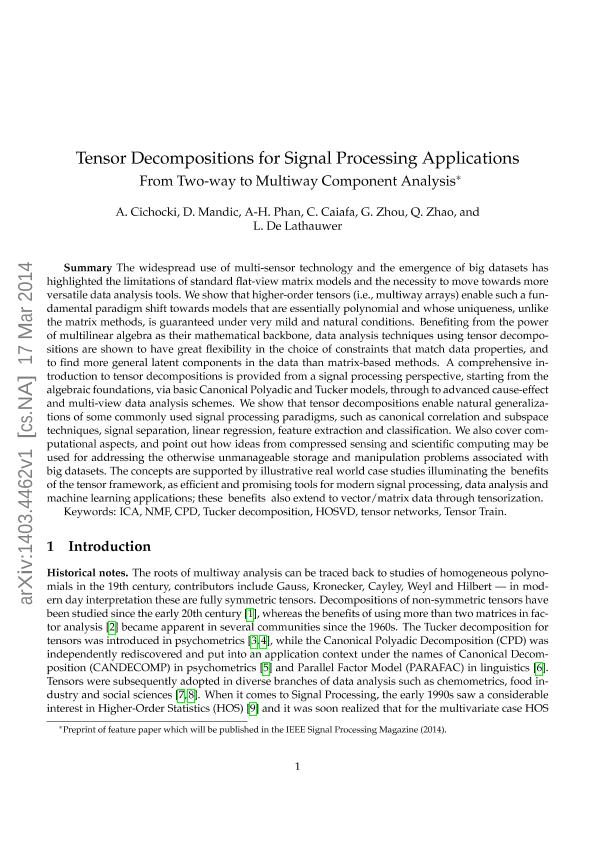Mostrar el registro sencillo del ítem
dc.contributor.author
Cichocki, Andrzej
dc.contributor.author
Mandic, Danilo P.
dc.contributor.author
Phan, Anh Huy
dc.contributor.author
Caiafa, Cesar Federico

dc.contributor.author
Zhou, Guoxu
dc.contributor.author
Zhao, Qibin
dc.contributor.author
De Lathauwer, Lieven
dc.date.available
2016-05-27T20:50:39Z
dc.date.issued
2015-03
dc.identifier.citation
Cichocki, Andrzej; Mandic, Danilo P.; Phan, Anh Huy; Caiafa, Cesar Federico; Zhou, Guoxu ; et al.; Tensor decompositions for signal processing applications: from two-way to multiway component analysis; Institute of Electrical and Electronics Engineers; IEEE Signal Processing Magazine; 32; 2; 3-2015; 145-163
dc.identifier.issn
1053-5888
dc.identifier.uri
http://hdl.handle.net/11336/5905
dc.description.abstract
The widespread use of multi-sensor technology and the emergence of big datasets has highlighted the limitations of standard flat-view matrix models and the necessity to move towards more versatile multi-way data analysis tools. We show that higher-order tensors (i.e., multiway arrays) enable such a fundamental paradigm shift towards models that are essentially polynomial and whose uniqueness, unlike the matrix methods, is guaranteed under very mild and natural conditions. Benefiting from the power of multilinear algebra as their mathematical backbone, data analysis techniques using tensor decompositions are shown to find more general latent components in the data than matrix-based methods, and to have great flexibility in the choice of constraints that match data properties. A comprehensive introduction to tensor decompositions is provided from a signal processing perspective, starting from the algebraic foundations, via basic Canonical Polyadic and Tucker models, through to advanced cause-effect and multi-view data analysis schemes. We also cover computational aspects and show that tensor decompositions enable natural generalizations of some commonly used signal processing paradigms, such as canonical correlation and subspace techniques, signal separation, linear regression, feature extraction and classification. We point out how ideas from compressed sensing and scientific computing may be used for addressing the otherwise unmanageable storage and manipulation problems associated with big datasets. The concepts are supported by illustrative real world case studies illuminating the blessings of the tensor framework, as efficient and promising tools for modern signal processing, data analysis and machine learning applications; these blessings also extend to vector/matrix data through tensorization.
dc.format
application/pdf
dc.language.iso
eng
dc.publisher
Institute of Electrical and Electronics Engineers

dc.rights
info:eu-repo/semantics/openAccess
dc.rights.uri
https://creativecommons.org/licenses/by-nc-sa/2.5/ar/
dc.subject
Tensor Decompositions
dc.subject
Component Analysis
dc.subject
Signal Processing
dc.subject.classification
Ciencias de la Información y Bioinformática

dc.subject.classification
Ciencias de la Computación e Información

dc.subject.classification
CIENCIAS NATURALES Y EXACTAS

dc.title
Tensor decompositions for signal processing applications: from two-way to multiway component analysis
dc.type
info:eu-repo/semantics/article
dc.type
info:ar-repo/semantics/artículo
dc.type
info:eu-repo/semantics/publishedVersion
dc.date.updated
2015-10-29T16:30:25Z
dc.journal.volume
32
dc.journal.number
2
dc.journal.pagination
145-163
dc.journal.pais
Estados Unidos

dc.journal.ciudad
Nueva York
dc.conicet.avisoEditorial
IEEE allows its authors to follow mandates of agencies that fund the author’s research by posting accepted versions of their articles in the agencies’ publicly accessible repositories.
dc.description.fil
Fil: Cichocki, Andrzej. Riken Brain Science Institute; Japón
dc.description.fil
Fil: Mandic, Danilo P.. Imperial College London; Reino Unido
dc.description.fil
Fil: Phan, Anh Huy. Riken Brain Science Institute; Japón
dc.description.fil
Fil: Caiafa, Cesar Federico. Consejo Nacional de Investigaciones Científicas y Técnicas. Centro Científico Tecnológico La Plata. Instituto Argentino de Radioastronomia (i); Argentina
dc.description.fil
Fil: Zhou, Guoxu . Riken Brain Science Institute; Japón
dc.description.fil
Fil: Zhao, Qibin. Riken Brain Science Institute; Japón
dc.description.fil
Fil: De Lathauwer, Lieven. Katholikie Universiteit Leuven; Bélgica
dc.journal.title
IEEE Signal Processing Magazine

dc.relation.alternativeid
info:eu-repo/semantics/altIdentifier/url/http://ieeexplore.ieee.org/xpl/articleDetails.jsp?arnumber=7038247
dc.relation.alternativeid
info:eu-repo/semantics/altIdentifier/doi/10.1109/MSP.2013.2297439
dc.relation.alternativeid
info:eu-repo/semantics/altIdentifier/doi/http://dx.doi.org/10.1109/MSP.2013.2297439
dc.relation.alternativeid
info:eu-repo/semantics/altIdentifier/url/http://arxiv.org/abs/1403.4462v1
dc.relation.alternativeid
info:eu-repo/semantics/altIdentifier/arxiv/1403.4462v1
Archivos asociados
